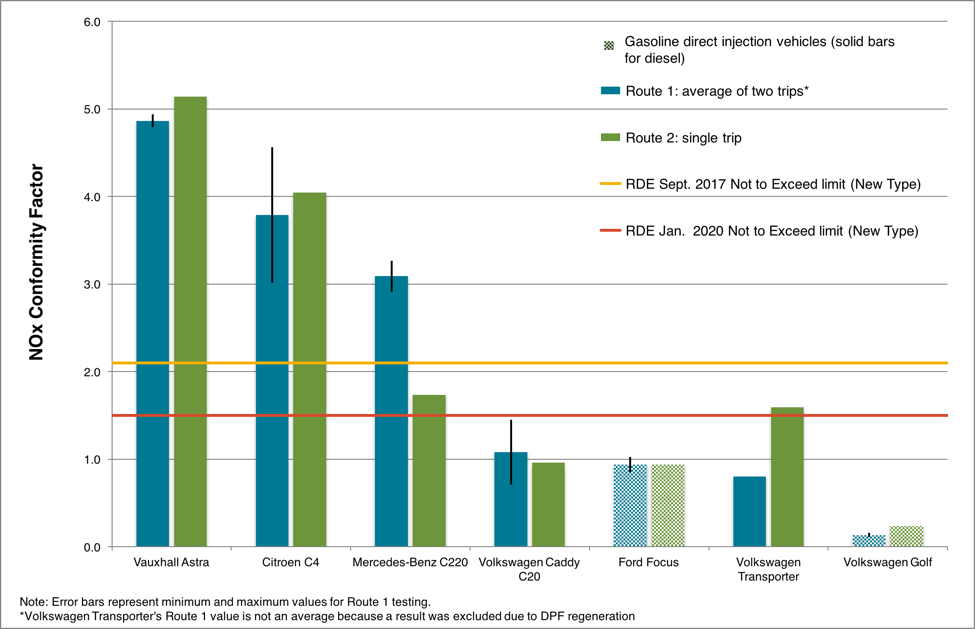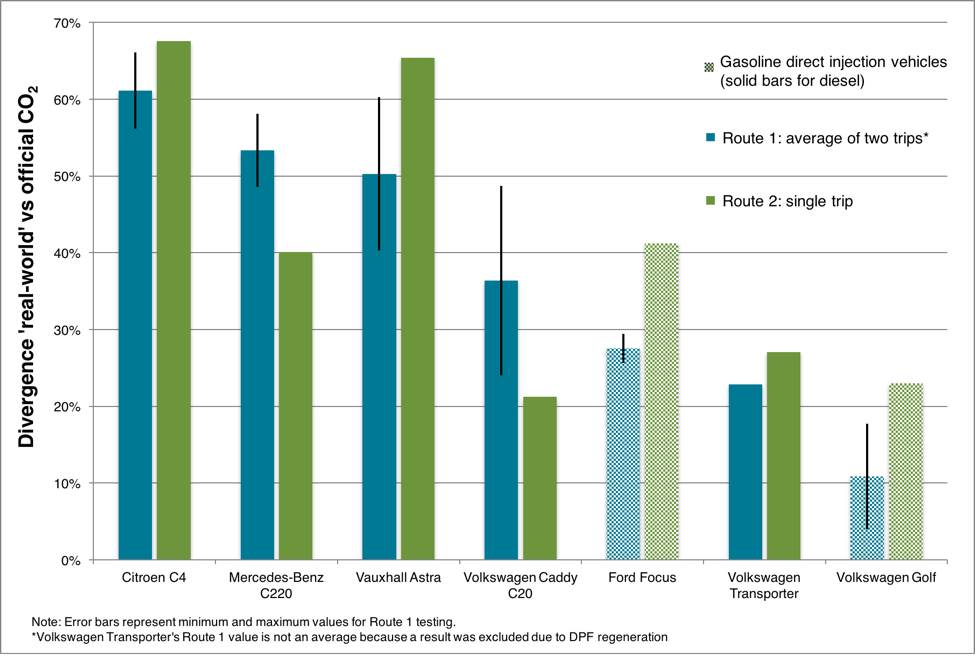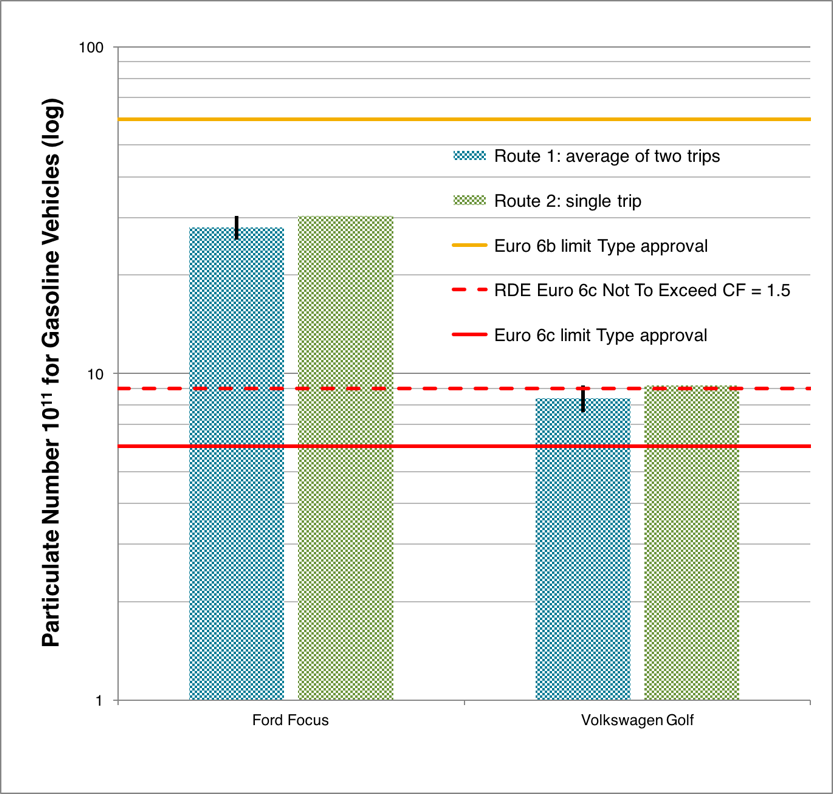On-road testing of CO2 and exhaust emissions from Euro 6 passenger cars in the EU
Blog
Adding to the pile of evidence: Recent on-road testing results for CO2 and exhaust emissions from Euro 6 light-duty vehicles in the EU
In late 2015, in the immediate aftermath of the revelations about Volkwagen’s cheating on vehicle certification tests in the United States, we commissioned Emissions Analytics, a commercial testing service specializing in real-world fuel consumption and emissions, to perform on-road emissions tests of the sort that first raised suspicions about VW on a number of Euro 6-regulated gasoline and diesel vehicles in Europe.
The table below shows the vehicles tested for this project. The final report from Emissions Analytics, here, details the methodology used and the results. But the report can be hard to interpret if you’re not immersed in the subject of vehicle emissions and regulations and haven’t been closely following the story of the gap between official and real-world vehicle exhaust emissions as it’s developed over the past year. So here’s a summary of what the Emissions Analytics testing found for nitrogen oxides (NOx) and particulates, which are significant health problems, and CO2 which is vehicles’ main contribution to climate pollution.

Methodology
The testing was performed using a Portable Emissions Measurement System (PEMS). Rental companies provided the vehicles, which were tested on public roads in the UK over two different routes. Route 1 included standard driving conditions with no air conditioning or cold start. Route 2 included higher acceleration rates, steeper hills, and air conditioning use. Both routes confirm to boundary-condition requirements of the EU Real Driving Emissions (RDE) test, although the results in the report represent raw emissions values, i.e. they were not corrected downwards or upwards using any of the available RDE trip analysis tools. Vehicles were tested twice over Route 1, once with the engine’s electronic control unit (ECU) disconnected to ascertain whether the ECU in operation triggered a change in the vehicle’s engine calibration that could affect exhaust emissions. In this case, no significant differences were found between test results obtained with the ECU in operation and with it disabled. (Detailed descriptions of the methodology and driving routes are provided in the full report.)
The ambient outside temperature for all of the tests remained between 7 ˚C and 11 ˚C, which is outside the temperature window specified for vehicle type approval testing in the EU. This is important because many manufacturers have admitted to significantly reducing the effectiveness of their NOx control strategy outside the ambient temperature windows mandated in the official test procedure, claiming that it’s necessary to protect the engine.
Findings
The charts below show average emissions for Route 1 and 2, where Route 1 represents an average of the two Route 1 trips (i.e., with and without a connection to the ECU. According to Emissions Analytics, under the same on-road testing conditions a NOx result is repeatable within a window of ± 25%, CO2 results are repeatable within a window of ± 10%, and particle number (PN) within ± 40%.
Figure 1 shows NOx emissions in terms of conformity factor, which is the ratio between the measured on-road NOx emissions and the regulated limit of 0.08 g/km for diesel vehicles and 0.06 g/km for gasoline vehicles. Because of the different regulations for gasoline and diesel vehicles, if a gasoline vehicle has the same conformity factor as a diesel vehicle, it is actually emitting less NOx than a diesel vehicle. In fact, the gasoline-powered Ford Focus emitted the same amount of NOx as the Volkswagen Transporter.
These results show that there can be considerable variation between routes, even when both fall within the RDE boundary conditions. The results also vary across the vehicles tested by more than one order of magnitude. The Volkswagen Golf, a gasoline vehicle, had a conformity factor of only ~0.1, while the Vauxhall Astra, a diesel vehicle, was approximately 5 times greater than the legal limit. Both tested gasoline vehicles fell below both the European Commission’s 2017 and 2020 RDE NOx limits, which are conformity factors of 2.1 and 1.5 relative to Euro 6 levels, respectively. Volkswagen’s diesel vehicles also fell below the 2017 RDE limit and below or just at the limit for 2020.

Figure 2 shows the gap between real-world CO2 emissions from the tested vehicles and the vehicles’ type-approval value for CO2, represented as a percent exceedance of the type-approval value. Like the findings for NOx, the gap between real-world and type approval values varies greatly, from 10% to almost 70%. This range is consistent with previous ICCT findings of an overall average gap of 40% between real-world and type approval CO2 values for newly registered passenger cars. The fact that Emissions Analytics found that no vehicles performed more efficiently on the road than they did during type-approval testing is unsurprising. The New European Driving Cycle (NEDC), the driving cycle used for vehicle type-approval tests, has a speed profile that is unrepresentative of typical driving conditions, and vehicle manufacturers are also able to exploit flexible aspects of the type-approval test protocol to artificially lower exhaust emissions during the tests—for example, by optimizing vehicle setup for the preliminary coastdown tests that produce road-load coefficients used to set up the vehicle emissions testing laboratory equipment.

Particle number, or PN, is a measurement of fine and ultra-fine particulates that threaten human health. Figure 3 shows PN results for the gasoline vehicles tested. Note that these values should be considered estimations of the order of magnitude of emissions only, because the Pegasor device used by Emissions Analytics is not certified yet for RDE testing. For reference, Figure 3 includes: (a) the Euro 6c PN standard of 6.0×1011/km, which applies to both diesel and gasoline direct injection vehicles and will take effect in September 2017; (b) the current Euro 6b standard of 6.0×1012/km, which was implemented in 2014; and (c) the anticipated regulation level for RDE, based on a conformity factor of 1.5 relative the Euro 6c type approval value, although this limit is still under discussion. (For the specific values set for Euro 6b and 6c, see here). Both gasoline direct injection vehicles’ PN values fall below the current Euro 6b standard. These findings also suggest that the Volkswagen Golf might pass an upcoming RDE regulation level with a CF of 1.5 relative to Euro6c, while the Ford Focus would need to reduce its PN by a factor of 3.

Policy Implications
Emissions of NOx and CO2 measured by the Emissions Analytics tests varied greatly. It’s noteworthy that all Volkswagen diesel vehicles and both gasoline vehicles fell below, or very close to, the future RDE conformity factors for NOx. These findings indicate that low real-world NOx emission levels are achievable with current technology, if applied correctly.
The implementation of the RDE test procedure, beginning in 2017, should improve NOx emission performance in vehicles, even though the current definition of conformity factors and boundary conditions is expected to limit the short term impact of the RDE regulation for reducing on-road NOx emissions of the vehicle fleet. (For more details on the RDE, see here.) As for CO2, the European Commission will implement a new Worldwide Harmonized Light Vehicles Test Procedure (WLTP) in 2017 that should help reduce the discrepancy between official and real-world CO2 emission levels. However, to prevent the CO2 discrepancy level from increasing again in future years, in-use conformity testing for CO2 similar to the RDE test procedure for air pollutants, will be needed. Finally, the PN results in this study suggest that for at least some gasoline direct injection vehicles, further reduction fine and ultrafine particulates will be necessary under upcoming regulations, either through the use of a more advanced injection technology that produces fewer particulates or a gasoline particulate filter.
